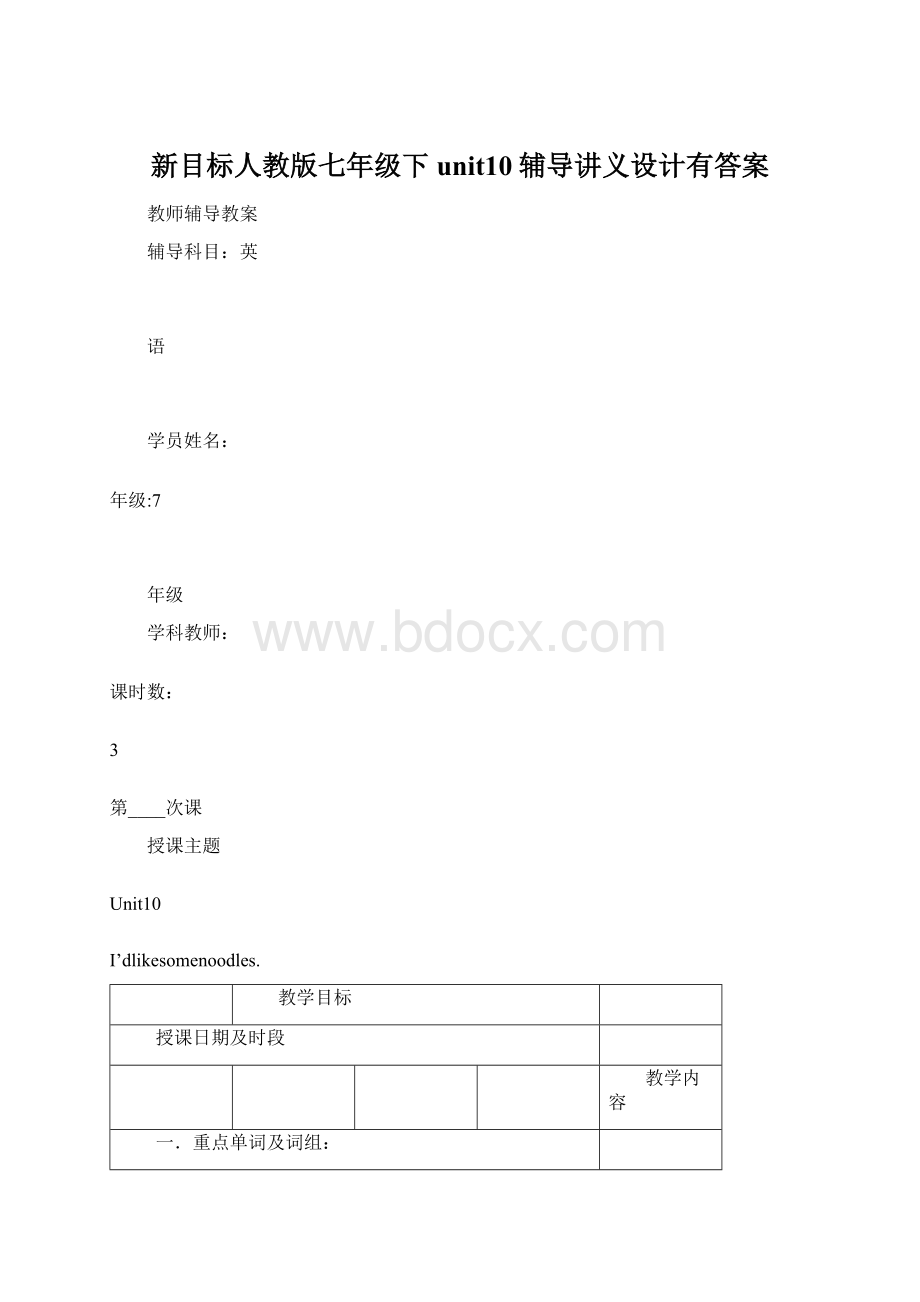新目标人教版七年级下unit10辅导讲义设计有答案Word文件下载.docx
《新目标人教版七年级下unit10辅导讲义设计有答案Word文件下载.docx》由会员分享,可在线阅读,更多相关《新目标人教版七年级下unit10辅导讲义设计有答案Word文件下载.docx(12页珍藏版)》请在冰豆网上搜索。

7、wouldlike
愿意;
喜欢
8、yet
adv〔常用于否认句或疑问句〕还;
仍然
9、order
n.&
v.点菜;
命令
10、meat
n.〔可食用的〕肉
11、fish
n.鱼;
鱼肉
12、aroundtheworld
世界各地
13、answer
n.答案v.答复
14、alargebowlofnoodles
一大碗面
15、takeone’sorder
点菜
16、greentea
绿茶
17、aroundtheworld
18、onone’sbirthday
在某人的生日
19、bedifferent
不同
20、bedifferentfrom
与不同
21、thenumberof
.....的数量
22、makeawish
许愿
23、inonego
一次性的,同一次
24、cometrue
实现
25、put...in...
把..放进..
26、getpopular
受欢送,流行
27、cutup
切碎
28、bethesame
相同
29、bringgoodlucktosb
给某人带来好运
30、beshortof
短缺,缺少
P.S.熟识词汇:
1、bracketn.支架;
括号2、traditionn.惯例,传统;
传说3、structuren.结构;
v.组织;
构成二.词义辨析:
1.large,big,huge,great的区别
用法例句large一般指物体的面积、空间、范围大,修Thereisalargelakenearourschool.饰物而不修饰人,反义词small,较bigalargenumberofpeople
更正式
big通常指具体事物的大小,如容积、体积、Heoftenhasabigappleforbreakfast重量、程度等,其反义词small或littleeverymorning.
huge指体积的巨大或超过标准的巨大,有“verylarge的〞意思。
great常修饰抽象的、无形的东西,精神上、程度上的大;
用在具体名词前,表示异
乎寻常的大,给人留下深刻的印象,
1)
【即学即练】Chinaisa_______andbeautifulcountry.
Thereisahugebuildingneartheriver.河边有幢大楼。
You'
regreat!
你真行!
Edisonwasagreatscientist.爱迪生
是位伟大的科学家。
Wearegoingtovisitthe______HallofthePeople.我们打算参观人民大会堂。
1.great2.Huge2.thenumberof,anumberof的区别
用法例句thenumberof“...的数量〞,后跟名词复数,作主Thenumberofstudentsinthe语时谓语动词用单数。
roomis50.
anumberof“许多...,〞后跟可数名词复数,作Anumberofstudentsareplaying主语时谓语动词用复数basketball.
【即学即练】
Anumberofmyfriends________(think)Ishouldtakeaholiday.
_______numberofstudentsisabouttwenty._______numberofusstudentsarefromsouth.
_______numberofpeoplewhoareillisfive.1.think2.The3.A4.The
三.
句型解:
1.I
’dlikesomenoodles.
我想要一些面条。
【解析】
wouldlike=want
想要
1)后接名或代,表示具体“要〞某西
I’dlikesomedumplings.wouldliketodo表示“想要做某事〞,常用有礼貌地提出邀、求或建。
They’dliketoplayfootballafterschool.3)wouldlikesb.todo想要某人做某事
She’dlikemetogoshoppingwithher.Wouldyoulikesome⋯?
用于委婉的提出建,或征求方意。
肯定答:
Yes,please.Yes,I’dlike/loveto
否认答:
No,thanks.
--Wouldyoulikesometea?
--Yes,please./No,thanks.
Wouldyouliketodo...?
你愿意去做
....?
--Wouldyouliketogoswimmingwithus?
Yes,I
’dloveto
【即学即】
I’dlikethem_____〔stay〕fordinnerwithus.Shelikes_____〔watch〕TVatnight.
–Wouldyoulikeacupoftea?
-_______.
4)A.I’dlikemilkB.Yes,IwouldC.You’rewelcomeD.Yes,pleaseTheywantsomegreentea.〔同句〕They________________greentea.
She’dlikesomerice.〔改一般疑句〕
______she__________rice?
1.tostay2.watching3.D4.wouldlikesome5.Wouldlikesome2.Yes,therearesometomatoes.是的,里面有些西柿。
以o尾的名复数有的要加-es,有的要加s,
1)小虎着琴〔piano〕听着收音机〔radio〕,又到物园〔zoo〕照了
相〔photo〕,
但考得
3个大蛋〔零分
zero〕,一律加
s;
2)黑人〔Negro〕英雄〔hero〕吃土豆〔potato〕和西柿〔
3.MayItakeyourorder?
可以点餐?
【解析】order里用作名,表示“点菜,叫菜〞。
tomato〕,全部
加
es.
takeone’sorder点餐,点菜
1)order可以用作,表示“叫⋯⋯点⋯⋯〞。
Areyoureadytoorderyet,madam
?
太太,你可以点菜?
2)“命令,嘱咐〞
ordersb.todosth
“命令某人做某事〞
Thedoctorordershimtostaythere.
作不可数名,“秩序,序〞Look!
Yourhouseisoutoforder!
order可构成inorderto...或inorderthat...了〞“Hegetsupearlyinordertocatchtheearlybus.=Hegetsupearlyinorderthathecancatchtheearlybus.Ifheorsheblowsoutallthecandlesinonego,thewishwillcometrue.如果他(她)一口气把蜡全部吹的,的愿望便会成真。
解析】
or是,意“和〞,用于否认句。
Idon’tlikeonions,greenteaorporridge.我不喜洋葱、茶和粥。
or可用作来表示,意“或者,否〞等。
Isitredorblack?
是红的还是黑的?
Bequick,oryou’belllate.
快点,否那么你就要迟到了。
在否认句中,如果所连的两个词前后都有否认词时,那么用and,而不用or来连接。
Ithasnoarmsandnolegs.=Ithasnoarmsorlegs.它没有胳膊,也没有腿。
2)
inonego相当于汉语中的“同一次〞,“一次性地〞,其中的介词还可以用
at,
即
atonego.
Youcan’tdotheworkallinonego.你不可能一次把工作都干完。
3)
cometrue表示愿望、梦想等的“实现〞或“成为现实〞。
Makeawish,anditcanreallycometrue.许个愿,它一定会实现的。
Keeponworkingandyourdreamwillcometrue.不断干下去你的梦想会实现。
四.语法专项:
名词分类
①
类别
概念
例子
可数性
个体名词
表示某类人或事物的个体。
普通
集体名词
表示假设干个体组成的集合体。
名词
物质名词
表示无法分为个体的实物。
抽象名词
表示动作、状态、品质等的抽象概念。
专有
表示某个/些人、地方、机构等专有的名称。
可数名词规那么构成:
一般直接加s以s,x,sh,ch结尾的,加es以辅音字母加y结尾的,变y为i加es(4)以o结尾的:
无生命的加s,有生命的加es
(1)局部不规那么名词:
大鹅老鼠齐步走,男男女女龇龇牙goose--geesemouse--miceman--menwoman--womentooth--teethfoot--feet单复数形式一致:
一个中国人和一个日本人骑着一只羊和鹿去吃水煮鱼ChineseJapanesesheepdeerfish以f或者fe结尾的:
直接加s海湾〔gulf)农奴〔serf)信〔belief)酋长(chief〕,悬崖〔cliff)证据〔proof)上顶〔roof)房加es小偷之妻生活难自己扫叶来做饭thiefwifelifeselfleaf忽见一狼躲架后拿刀把它劈两半wolfshelfknifehalf既可加s又可加es码头侏儒围围巾手绢复数变二心wharfdwarfscarfhandkerchief②可数名词复数形式的不规那么构成法英语中有一局部名词由于历史或词源原因其复数形式的构成法是不规那么的。
这种情况主要有:
元音字母变化如:
foot-feettooth-teeth
man-mengoose-geese
.
woman-womenmouse-mice
(2)结尾为-en
如:
child-children单复数同形如:
sheep,fish,Chinese,Japanese,deer只有复数形式如:
trousers,goods等【即学即练】sheep______tooth_____deer____German__________manworker_________Chinese_________Japanese_________Englishman__________Frenchman_________American_________
sheepteethdeerGermansmenworkersChineseJapanese
EnglishmenFrenchmenAmericans③不可数名词不可数名词的用法特征主要有以下几种:
不带冠词的单数形式需用动词单数作谓语。
Knowledgeispower.知识就是力量。
由much,little等词修饰。
Theyhavesavedmuchmoneyforfutureuse.他们存了很多钱以备未来使用。
(3)与表示单位的量词如apieceof等连用。
Goandfetchmeapieceofchalk.给我去拿一支粉笔。
要十分注意的是:
不可数名词不能与不定冠词或数词直接用在一起。
如不能说agoodnews,anadvice,ahardwork等。
不可数名词可以与量词使用构成不同的词组:
apieceofpaperadropofwaterabottleofmilk
a1oafofbreadabagofmoney【即学即练】
1)Iwanttobuy________.A.twobottlesofinkC.twobottleofinks
B.twobottleofinkD.twobottlesofinks
Theydon’thavetodo_______today.A.muchhomeworkB.manyhomeworks
C.manyhomeworkD.muchhomeworksSheep_______whiteandmilk_______alsowhite.
A.is,areB.are,isC.is,isD.are,are4)It’salong______toParis.It’stwothousandkilometers.A.streetB.roadC.wayD.end
Therearethree______andseven______inthepicture.A.cows,sheepsB.cows,sheepC.cow,sheepD.cow,sheeps
1-5AABCB
④专有名词用来指具体的人、地点、日子或物体的专有名称。
其特点是:
第一个字母大写,通常不与冠词连用,无复数形式。
人名
英美人的姓名与中国人的恰恰相反,姓在后面,名在前面,姓名前通常不用冠词。
MarySmith;
GeorgeWashington。
〔1〕一般熟人间通常用名称呼。
How’sJohngettingon?
〔2〕在不熟悉人之间或表示礼貌时,常把姓和称谓连用。
WouldyoupleasetellJohnSmithtocometotheoffice?
3〕姓氏复数前加定冠词可表示全家人。
TheTurnershavegonetoAmerica.地名〔1〕大局部单数形式的地名不用定冠词。
Asia;
America;
China;
London;
Shanghai〔2〕大局部单数形式的湖、岛、山名前不加定冠词。
SilverLake;
MountTai〔3〕山脉、群岛、海洋、河流、运河、海湾、海峡、半岛、沙漠名前一般加定冠词。
thePacific;
theEnglishChannel;
theSahara
日期名
〔1〕节日名前通常不用冠词。
〔2〕星期名前通常不用冠词。
〔3〕月份名前通常不用冠词。
Christmas;
NationalDaySunday;
Tuesday
April;
December
五.练习:
1.单项选择
()1.—_______?
—Yes,I’dlikesomemilk.A.WhereareyouB.WhatdoyoudoC.CanIhelpyouD.Howcanyougetthemilk()2.Someoranges______inthebag.Somechicken_____onthetable.A.is,isB.are,areC.are,isD.is,are()3.Idon’tlikebeef,mutton_______chicken.Ijustlikepotatonoodles.A.andB.butC.orD.so
()4.—What_____doyouhave?
—Wehavesmall,medium,largebowls.A.kindB.sizeC.colorD.other()5.He’dlikeabowlof______noodles.A.tomatoandeggB.tomatoesandeggC.tomatoesandeggsD.tomatoandeggs()6.—Wouldyoulikesome_______?
—Oh,yes.Justone.A.pearsB.orangeC.sugar(糖)D.meat
()7.—CanIhelpyou?
—Yes,I’dlikefive______andsomepears.A.potatoB.tomatoesC.meatD.banana()8.—Wouldyoulikesomegreentea?
—_____.A.Yes,please.B.No,please.C.No,Idon’t.D.Yes,Iwould.()9.—Doyoulikefruit?
—Yes,Ilike______best.A.potatoB.chickenC.strawberriesD.bread1-5CCCBA6-9ABAC
2.完型填空
Peopleindifferent1liketoeatdifferentfood.2kindoffooddopeopleintheUK
3toeat?
Fishandfried
4
chips(条)arevery5intheUK.
Sometimespeople
6
themathome,buttheyusuallygotoafastfood7
tobuythem.
Theycanhavethem8
therestaurantor9
themawayhome.Sometimes,they
10liketoe
attheminapark.
(
)1.A.country
B.countries
C.city
)2.A.Who
B.When
C.What
)3.A.wouldlike
B.like
C.likes
)4.
A.potato
B.potatoes
C.potatoes
)5.
A.cheap
B.large
C.popular
)6.
A.cooking
B.cook
C.cooks
)7.A.restaurant
B.library
C.supermarket
)8.A.in
B.on
C.under
)9.
A.get
B.bring
C.take
)10.A.and
B.also
C.too
1-5BCBAC
6-10BAACB
阅读理解InmanyEnglishhomes,peopleeatfourmealsaday:
breakfast,lunch,afternoonteaanddinner.Peoplehavebreakfastatanytimefromseventonineinthemorning.Theyeatporridge,eggsorbread.Englishpeopledrinkteaorcoffeeatbreakfast.
Lunchcomesatoneo’clock.Afternoonteaisfromfourtofiveintheafternoonanddinnerisabouthalfpastseven.Firsttheyhavesoup.Thentheyhavemeatorfishwithvegetables.Afterthattheyeatsomeotherthings,likebananas,apples,ororanges.ButnotallEnglish
peopleeatlikethat.Someofthemhavetheirdinnerinthemiddleoftheday.Theirmealsarebre
akfast,dinner,teaandsupperandallthesemealsareverysimple.()1.ManyEnglishpeoplehave_____mealsaday.
A.twoB.threeC.fourD.threeorfour
A.beforesevenB.atanytime
C.aftersevenD.atanytimefromseventonine)3.Teacomes_____.
A.atoneB.aftersupperC.beforesupperD.atanytime
()4.Englishpeopledon’thave_____fordinner.
A.porridgeB.meatorfishC.bananasorapplesD.soupormeat()5._____ofEnglishpeoplehavetheirmealsinthemiddleoftheday.
A.FewB.SomeC.MostD.Lots
1-5CDCAB